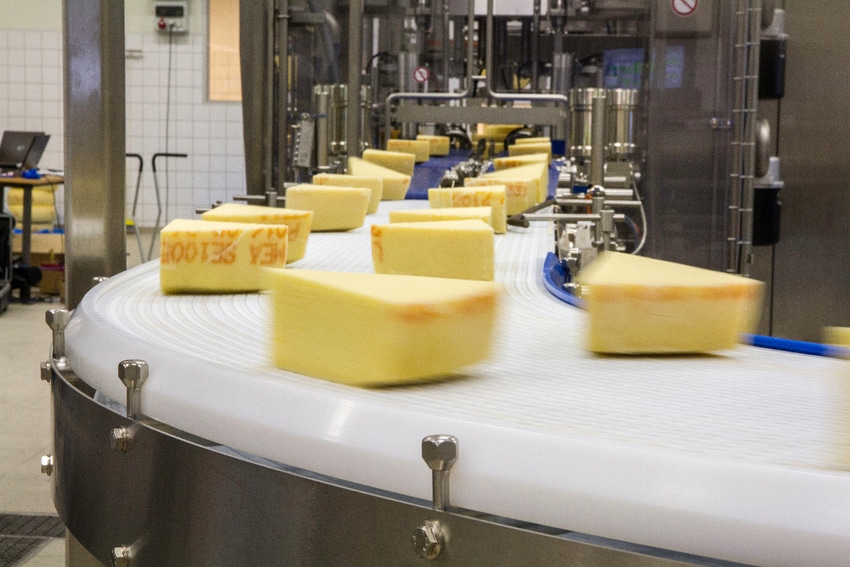What to look for in a hygienic conveyor design

Selecting conveyors with hygienic design is critical to maintaining food safety on your packaging line. How do you recognize a hygienic design? Conveyor expert Ken Lento touches on a few features to look out for—both good and bad.
According to the Centers for Disease Control and Prevention (CDC), each year foodborne illnesses sicken nearly 128,000 individuals and result in 3,000 deaths in the U.S. Despite incorporating protocols such as frequent washdowns, food manufacturers often struggle to maintain clean conveyors along processing and packaging lines. Exposed conveyor systems remain vulnerable to contamination that ranges from unwanted pathogens to leaks that occur along a production line.
Selecting conveyors with hygienic design is critical to maintaining food safety on your packaging line. How do you recognize a hygienic design?
Ken Lento, senior business strategist, Optical and Food, for leading conveyor manufacturer Flexlink Systems Inc., will be presenting an Innovation Stage session on hygienic equipment design at Pack Expo East 2017 (Feb. 27-March 1; Philadelphia). He has more than 25 years of experience in material handling, specializing in precision assembly, lab automation and food manufacturing. Lento’s presentation, entitled “Safely Producing Food with Good Hygienic Equipment Designs and Practices,” takes place on Tues., Feb. 28, at 11:30 a.m. at the Innovation Stage Booth 759.
Here, Lento talks about the importance of conveyor equipment design in reducing the potential of foodborne pathogens entering the supply chain and what you can do today.
What are some industry concerns regarding food safety?
Lento: Food manufacturers have always maintained a focus on reducing the potential for foodborne illnesses in processing operations, but one area that continues to be a challenge is ensuring the cleanliness of conveyor systems. Conveyors can be particularly vulnerable to bacterial growth, including pathogens such as listeria. All it takes is one scratch on a metal conveyor to be a source of harmful bacterial growth.
One manufacturer, for example, was fined $11 million after a building leak contaminated a food conveyor and resulted in consumers getting sick. This is a problem that continues to impact the food industry.
What are some common sources of bacterial growth?
Lento: Bacteria will grow in areas where water gets trapped. It also grows under poor hygienic conditions, which can include improper or incomplete cleaning. If companies have discovered contamination, they need to have a thorough process in place to ensure that they are implementing the correct protocols. This includes rigorous testing.
Even with proper protocols, conveyor systems that are not hygienically designed can be inherently vulnerable to bacterial build-up.
What hygienic design options should manufacturers look for in conveyors?
Lento: There are about 10 fundamental design elements that food manufacturers need to follow with respect to equipment, including conveyor systems.
The most important rule is to avoid metal-to-metal contact.
Also, water can build up behind screw heads and be a source for bacterial growth. To avoid trapping water, surfaces should be sloped and not flat, and hollow tube bodies should be avoided because they can trap water as well.
And it’s important to assure worker accessibility to all components so that they can be easily cleaned. I have seen conveyor systems with chains and belts that are difficult to reach. This makes effective cleaning more difficult and increases the risk of bacterial contamination.
What are some first steps that manufacturers should consider?
Lento: Manufacturers need to take a hard look at their conveyors and, for that matter, other equipment to ensure proper hygienic design. They should look for suppliers that use FDA-compliant materials for food safety.
Suppliers should also be certified by a reputable organization such as 3A Sanitary Standards Inc., which outlines recognized standards for equipment cleanliness. This shows that manufacturers have taken important steps to improve hygiene in the design and manufacturing processes.
Does the Food Safety Modernization Act (FSMA) require manufacturers to incorporate upgrades to conveyor equipment?
Lento: The FSMA does not specify design requirements, but the new law does raise the attention level for sanitary food handling. Companies need to start recording and monitoring their processes, including doing more risk analyses. If companies were not motivated to make changes beforehand, FSMA now adds a sense of urgency.
Beyond FSMA, it just makes good business sense to incorporate properly designed equipment and ensure sanitary protocols. All it takes is one incident of foodborne illness to wreak havoc with your brand. Manufacturers cannot afford to take that risk.

Sean Riley is the senior director, Media & Industry Communications, for PMMI, The Association for Packaging and Processing Technologies and owner/organizer of the Pack Expo portfolio of tradeshows. He began his work with PMMI in 2006 as editor of its Packaging Machinery Technology magazine. He is a member of various industry organizations including the International Packaging Press Organization (IPPO) and the American Society of Business Press Editors.
About the Author(s)
You May Also Like




